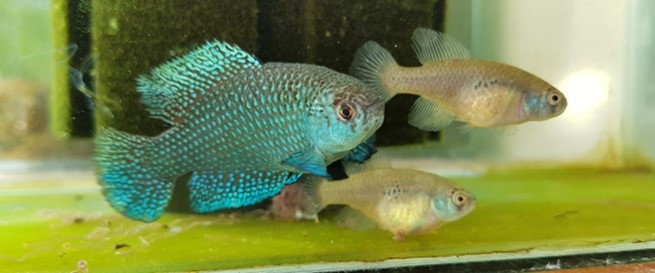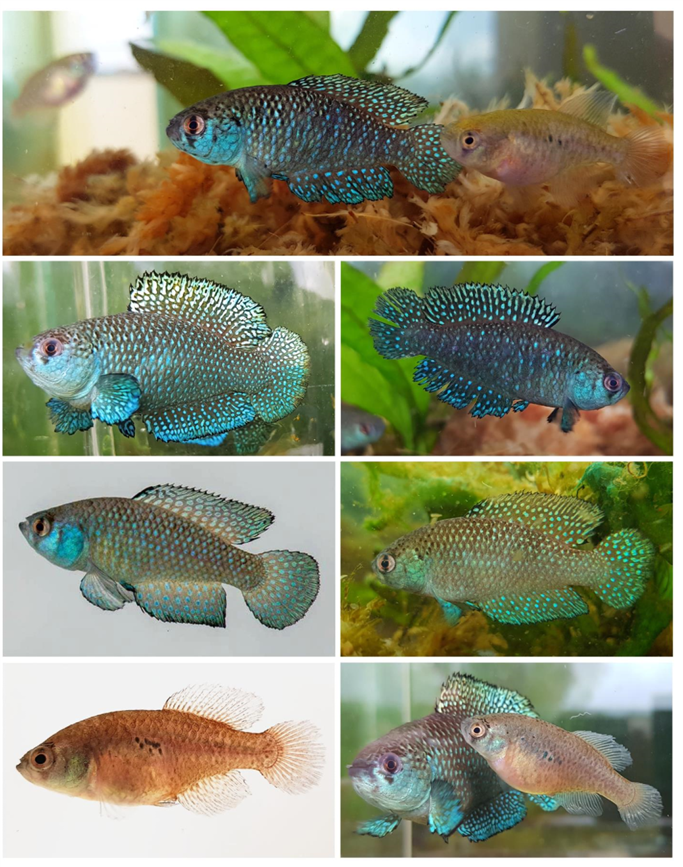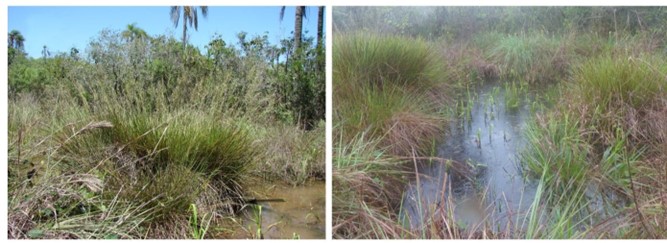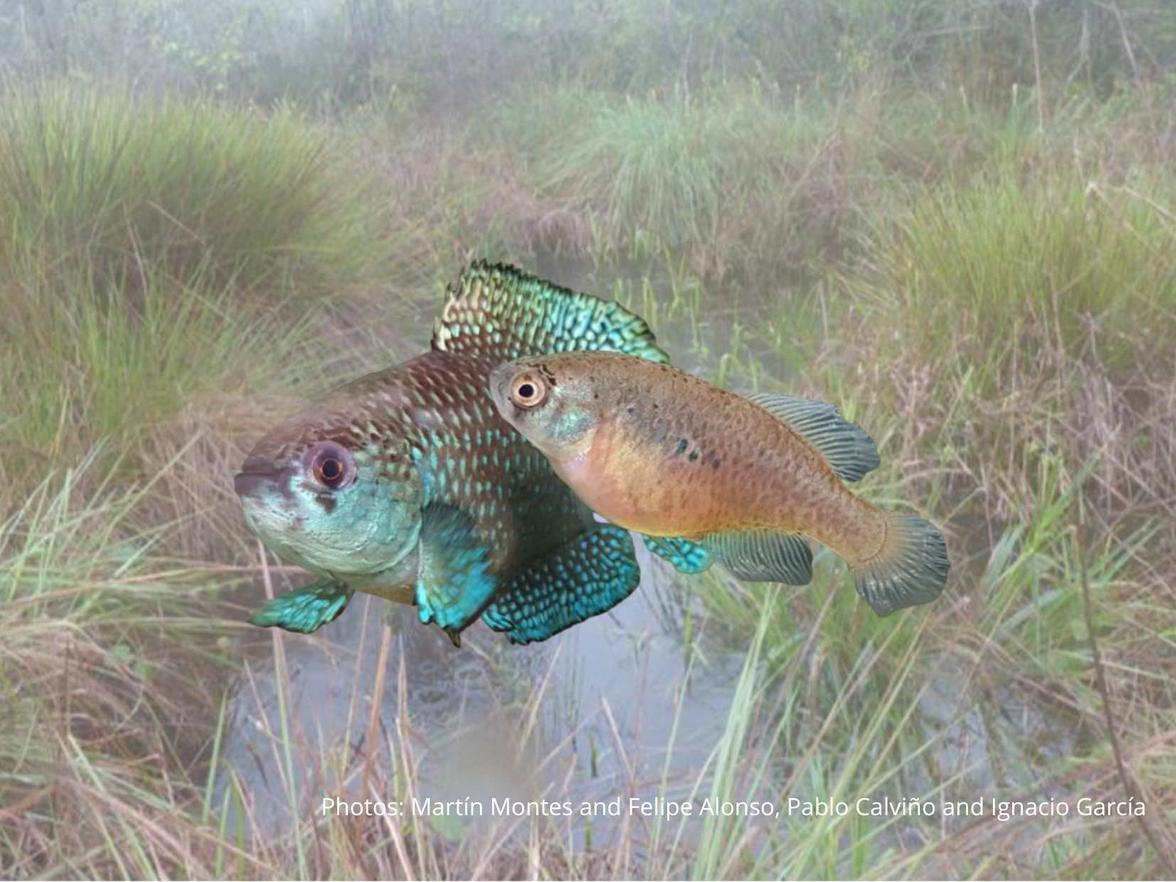In the temporary ponds of the Middle Paraná River, in the heart of the province of Misiones, Argentina, a new seasonal fish species has been discovered: Argolebias guarani. This species exhibits a striking coloration in males, with their bodies and fins completely covered with turquoise iridescent blotches. This astonishing fish inhabits ponds that form during rainfall and completely dry up for a part of the year, where it successfully completes its life cycle thanks to its desiccation-resistant eggs. This significant finding, published in the prestigious scientific journal Zoological Journal of the Linnean Society, represents a significant advancement in our understanding of aquatic biodiversity in the South American region and raises intriguing questions about the evolution and conservation of these fish.
Background
The discovery of a new species within this fish family (Rivulidae) is not common in Argentina, and it took several years for a new Killifish to come to light. The new species belongs to a group of small, highly colorful fish popularly known among aquarists as seasonal Killifish or annual fish. These fish inhabit temporary ponds that fill up with rainwater and completely dry out for at least part of the year. Their ability to survive in these environments is due to remarkable adaptations, with one of the most notable being the presence of desiccation-resistant eggs. When the pond dries up, these eggs remain buried in the sediment, and although the adults do not survive, the eggs do. With the next rainfall, the eggs hatch, and the fish "reappear" in the pond. For this reason, they are often called "cloud fish" or "rain fish," as they seem to magically appear when it rains. Within this group of fish is the genus Argolebias, to which the new species belongs, primarily distributed in the lowland areas associated with the middle and lower basins of the Paraná and Uruguay rivers, spanning the countries of Argentina, Paraguay, Brazil, and Uruguay. Initially, Brazilian researcher W.J.M. Costa proposed in 2008 that Argolebias be a subgenus within the genus Austrolebias. However, in the study recently published by Alonso et al. (2023), its status was elevated to a full genus. Among other distinguishing features from other genera in the Rivulidae family to which it belongs, Argolebias males display bright spots that merge along the outer margin of the dorsal fin and pectoral fins with bright markings on their centers and edges, in addition to various skeletal characteristics.

Figure 1. Male and two females of Argolebias guarani, Misiones, Argentina. Type specimens. Photograph: Pablo Calviño.
Aggressive behavior between male Argolebias guarani in an aquarium
In addition to the newly discovered species, Argolebias guarani, two previously known species were included in this genus: Argolebias nigripinnis and Argolebias paranaensis. This exciting finding was originally published in the article titled "From the mud to the tree: phylogeny of Austrolebias killifishes, new generic structure, and description of a new species (Cyprinodontiformes: Rivulidae)". For more information on the nomenclature and phylogeny of this group, we recommend reading the article that addresses these issues in the mentioned work, which is found in Volume 13 of this series ("Documentos de Divulgación" of the National Museum of Natural History).
Argolebias guarani
The newly published species in July 2023 by authors Alonso, Calviño, Terán, Serra, Montes, García, Barneche, Almirón, Ciotek, Giorgis & Casciotta, can be distinguished from other species by its unique coloration (Figs. 1 and 2, Video). In live mature males, it exhibits small irregular dark brown to gray spots on the lateral and anterior portion of the head. Additionally, it has abundant and relatively large subquadrate iridescent turquoise to light blue spots on the dorsal, anal, and caudal fins, distributed uniformly, with some elongated and fused along the outer margin of the dorsal fin. Moreover, the trunk and caudal peduncle display a reticulated brown to gray pattern with turquoise spots, formed by the sum of the scales in this area with their iridescent turquoise anterocentral portion and gray edges. Furthermore, the scales on the dorsal part of the trunk below the dorsal fin have a totally unique iridescent turquoise outer and thinner border. Other distinctive features include the anteriorly directed nostrils that are pointing slightly downwards, and in juveniles and young adults, a yellowish-orange background coloration at the base of the odd fins and a yellowish belly.
Argolebias guarani can be distinguished from Argolebias nigripinnis by several characteristics. In mature males of A. guarani, there are dark gray spots on the head, contrasting with the absence of spots in Argolebias nigripinnis. Additionally, the reticulated pattern formed by the scales on the body flanks, with a dark border and iridescent turquoise center, clearly distinguishes A. guarani from A. nigripinnis, which only has some iridescent marks aligned vertically on the body flanks, forming a series of discontinuous vertical lines of dots on a dark gray to black background. Another distinctive feature of A. guarani is the presence of irregular spots on the distal margin of the dorsal fin that merge but do not form an iridescent band below the dorsal fin edge, as seen in A. nigripinnis.
Compared to Argolebias paranaensis, for which there is no information on its coloration in life, Argolebias guarani can be differentiated by having more rays in the pectoral fins in both sexes, a proportionally shorter caudal fin, and proportionally smaller eyes. In males, Argolebias guarani also shows the dorsal fin origin anterior to the anal fin origin, whereas in Argolebias paranaensis, the dorsal fin starts behind the anal fin origin.
One of the most interesting characteristics of this species is the coloration of juvenile males and young adults, which have a light orange background color on the body and odd fins. This is a unique feature among the species of the "Austrolebias group of genera." As they mature, their bodies darken with melanophores, combining with the background color to give a brownishorange tone, which becomes darker grayish-orange as the males further mature.
Behavioral observations in captivity
The reproductive behavior of Argolebias guarani in aquarium conditions is similar to that of other killifish species. Males perform a lateral display towards females, spreading their unpaired fins and opening their opercula (video). They then make lateral movements of the body, pointing towards the substrate with their heads. Once the female pairs with the male, both excavate in the substrate where the eggs are deposited and fertilized, a process that lasts approximately 50 seconds. After spawning, the fish emerge from the substrate.
Egg incubation
After removing the spawning substrate from the aquarium and draining it for storage at room temperature, it was observed that the majority of the eggs were in a hatching condition after approximately 2 to 3 months.
Distribution and ecology
To date, Argolebias guarani has been recorded only in a seasonal pool located in the Defensa Natural Reserve in Puerto Península, a few hundred meters from the Paraná River and a few kilometers south of Puerto Iguazú, in the northern province of Misiones, Argentina. This location makes it the northernmost distributed species within the genus.
The pool where Argolebias guarani inhabits is characterized by clear waters, with a depth of approximately 80 cm and a soft sediment bed with an abundant amount of organic matter. Although there is no submerged aquatic vegetation, the margins of the pool are densely covered in grass and surrounded by lush jungle (Figure 3).
It is important to note that the habitat of A. guarani does not appear to follow a predictable filling and drying cycle over time. During several samplings conducted between 2017 and 2019, freshly hatched juvenile individuals were found in different months of the year, without showing a clear seasonality that is common in similar species. This suggests that this species may undergo multiple reproductive cycles in the same year.
Conservation
The only known population of Argolebias guarani is found in a natural reserve in a single pool. After conducting an assessment of its extinction risk using the criteria of the International Union for Conservation of Nature (IUCN), it has been classified as a Vulnerable species.

Figure 2. Argolebias guarani, Misiones, Argentina. Type specimens. Photographs: Pablo Calviño and Ignacio García. 2023.
The coloration pattern of Argolebias guarani apparently exhibits less variability in the studied specimens compared to what is typically observed in populations of other similar species, such as Austrolebias bellottii. Evolutionary mechanisms that explain these differences may involve genetic drift and genetic bottlenecks, which reduce genetic diversity. On the other hand, in cases like Austrolebias bellottii, greater phenotypic variability may be attributed to larger and older populations, as well as the presence of a more variable environment. Environmental challenges can exert diverse selective pressures, allowing for the development of different phenotypic traits in response to a changing environment. These factors can influence the expression of phenotypic traits and contribute to greater phenotypic variability in different populations. Further genetic studies are needed to evaluate these hypotheses and gain a better understanding of the mechanisms that affect phenotypic variability in these species.
Etymology
The specific epithet (the second word in the scientific name), guarani, was chosen in honor of the Guarani indigenous people who live in the area of the species' type locality, as a way to pay tribute to and value them.
Conclusions
The protection and conservation of Argolebias guarani and its habitat are crucial to ensure the survival of this unique species. Proper management of the natural reserve and effective conservation policies are needed. Further research is required to better understand the ecological needs and reproductive patterns of Argolebias guarani, as well as to assess its presence in other areas of the region.
Moreover, it is essential to engage local communities and raise awareness about the importance of protecting these species and their environments. Temporary wetlands are highly vulnerable and prone to disappearance due to their small size and the general lack of recognition of their value. The discovery of this species highlights the importance of studying and conserving these habitats, as well as generating awareness and appreciation among local communities. Environmental education and the promotion of sustainable practices for natural resource use play a vital role in long-term conservation.

Figure 3. Natural habitat of Argolebias guarani, Misiones, Argentina. Photographs: Martín Montes and Felipe Alonso.
The discovery of Argolebias guarani highlights the incredible biological diversity that is yet to be discovered on our planet. Each new finding brings us closer to understanding the complexity of aquatic ecosystems and the importance of their conservation. It also underscores the ongoing need to research and protect natural habitats, especially those that are fragile and endangered.
In summary, the discovery of this new seasonal fish species in Argentina provides a fascinating glimpse into the biodiversity of the region and raises questions about its evolution and adaptation. However, its limited distribution makes it vulnerable to events that can impact its population, such as climate change and diseases. It is crucial to implement effective conservation measures and promote environmental awareness, research, and protection of this group of fish about which we still know little. Only through these efforts can we preserve the natural richness of our planet for future generations.
Acknowledgements
We would like to express our sincere gratitude to all members of the Killifish Foundation and Autóctonos de Uruguay. We also extend our thanks to Marcos Mirande, Fernando Lobo, Virginia Martínez, Gastón Aguilera, and Baltazar Bugeau for their invaluable support. We are grateful to Andrés Bosso (DRNEA-APN), Sergio Arias Valdecantos (PN Iguazú-APN), Mario Beade (PN Campos del TuyúAPN), and Paula Cichero (DNC-APN) from National Parks for their invaluable collaboration. Finally, we thank Gianpiero Bosi for his collaboration in the maintenance and breeding of this species in the aquarium.
References
Alonso F., G.E. Terán, W.S. Serra Alanís, P. Calviño, M.M. Montes, I.D. García, J.A. Barneche, A. Almirón, L. Ciotek, P. Giorgis, J. Casciotta. 2023. From the mud to the tree: phylogeny of Austrolebias killifishes, new generic structure and description of a new species (Cyprinodontiformes: Rivulidae). Zoological Journal of the Linnean Society. XX, 1–30. https://doi.org/10.1093/zoolinnean/zlad032
Costa, W.J.E.M. 2008. Catalog of Aplocheiloid killifshes of the world. Reproarte, Rio de Janeiro, 127 pp.
Serra, W.S., G. Terán, P. Calviño, J.A. Barneche, M.M. Montes, I. García & F. Alonso. 2023. Descubriendo los secretos de los killis sudamericanos: nuevos géneros y su evolución. Documentos de Divulgación, Museo Nacional de Historia Natural, 13: 1-24.
- Killifish Foundation, La Plata, Buenos Aires, Argentina
- Museo Nacional de Historia Natural, Montevideo, Uruguay
- Centro Universitario Regional del Este (CURE) Sede Rocha, Rocha, Uruguay
- Instituto de Limnología “Dr. Raúl Ringuelet” (ILPLA) - UNLP – CONICET, La Plata, Buenos Aires, Argentina
- Fundación Miguel Lillo. San Miguel de Tucumán, Tucumán, Argentina
- Centro de Estudios Parasitológicos y de Vectores - [CCT-CONICET - La Plata], La Plata, Buenos Aires, Argentina
- Instituto de Bio y Geociencias del NOA (IBIGEO), CONICET-UNSa, Salta, Argentina
Photographs and video: Pablo Calviño, Ignacio García, Martin Montes, Felipe Alonso
MUSEO NACIONAL DE HISTORIA NATURAL
CASILLA DE CORREO 399
11.000 MONTEVIDEO, URUGUAY
e-mail: mnhn@mec.gub.uy
http://www.mnhn.gub.uy
